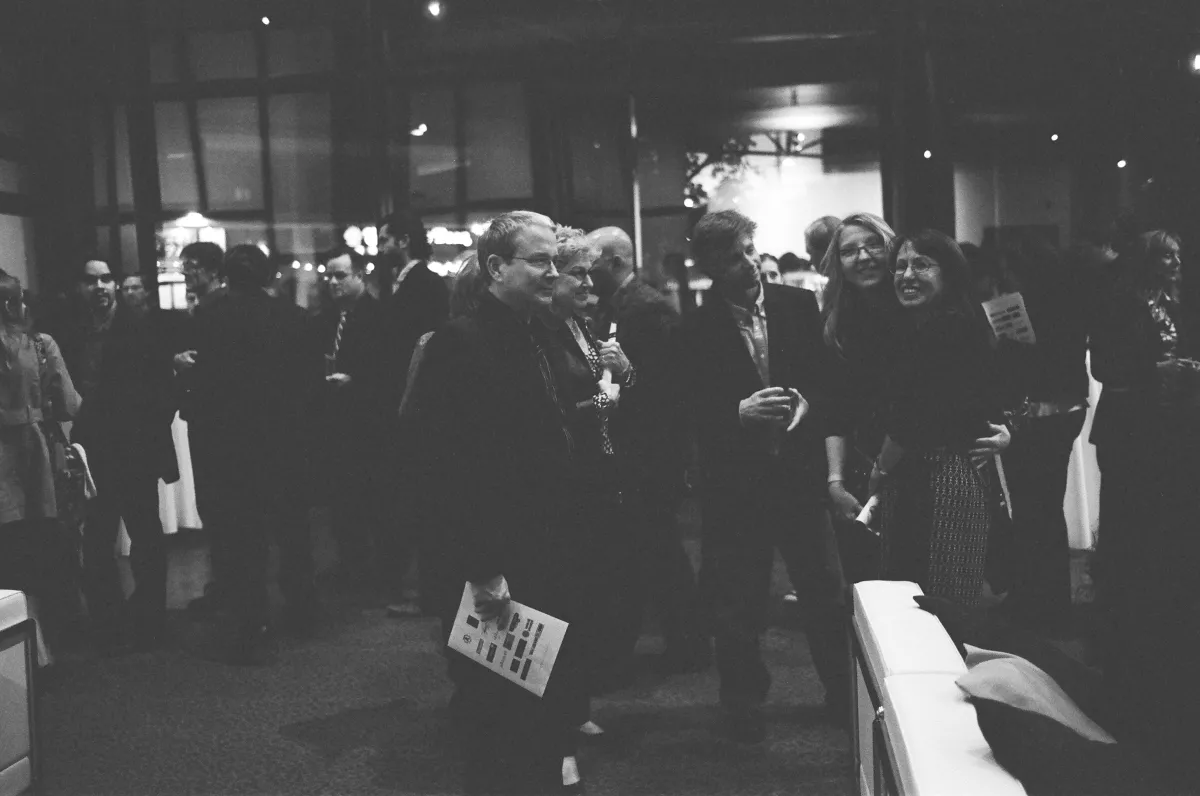

2008 IDA Awards. Image credit: M Madison
This piece was first published in Documentary’s Winter 2024/2025 issue, with the following subheading: From film festivals to the Oscars, one writer traces changes in how topicality, commercial success, and critical acclaim lead to documentary awards.
The war-torn streets of a besieged Ukrainian city. An exiled Russian opposition leader. A cultural festival celebrating Black pride in the 1960s.
A curriculum of history lessons is not the thing that connects these descriptions. Rather, they’re chapters in the unfolding legacy of documentary storytelling—a form that has grown increasingly central to understanding our shared reality. Films like 20 Days in Mariupol (2023), Summer of Soul (2021), and Navalny (2022) represent only recent entries in a decades-long journey, punctuated by high-profile accolades at global festivals and culminating, sometimes controversially, at the Academy Awards.
Yet as the stakes for documentary films rise in line with global crises and pressing social concerns, the road to recognition for these works is neither straightforward nor easily predicted. They pass through a patchwork of critical benchmarks, often starting at festivals like Sundance, Cannes, Venice, IDFA, and sometimes all the way to the Academy Awards, among others—each step shaping public perception and relevance. The question remains, however: What makes a documentary truly worthy? In a field where artistry intersects so directly with activism, prestige can blur with politics and honoring the “best” documentary is often as subjective as it is contentious.
So, do awards serve as a final validation—or merely a lens through which we evaluate a documentary’s impact? As recognition builds for documentaries across this vast circuit, the answer becomes both more layered and more essential.
It’s been a good stretch of time since Steve James’s Hoop Dreams (1994), Errol Morris’s The Thin Blue Line (1988), Joe Berlinger and Bruce Sinofsky’s Brother’s Keeper (1992), and Jennie Livingston’s Paris Is Burning (1990) were tussling for the most basic scraps of recognition from the Academy despite their significant cultural statuses. Starting with their film festival awards at Sundance and Berlinale, these films still carry a lasting cultural legacy—a phenomenon as old as film festivals themselves.
When Hoop Dreams was shut out of the Best Documentary Feature Oscar nominations, the late critic Roger Ebert famously called it “one of the most shocking omissions in Academy history,” arguing that the snub exposed the Academy’s disregard for documentaries as serious art. To Ebert, Hoop Dreams was “one of the great moviegoing experiences of my lifetime,” radical in every respect: a three-dimensional look into the lives of two young Black men, Arthur Agee and William Gates from Chicago’s inner city, pursuing a basketball dream as told in 1994, yet somehow omitted from the grace of prestige.
Although it did earn a nomination for Best Film Editing—an unusual nod for a documentary, the Academy’s exclusion of Hoop Dreams from the Documentary category was reportedly influenced by a flawed voting process. The documentary branch at the time used a point-based voting system that often disadvantaged films with niche appeal, possibly leading to the snub despite its critical success.
Outrage over the oversight bellowed through the critic world, laying bare a longstanding frustration with the Academy’s documentary committee, long criticized for sidelining long-lasting, culturally significant films in favor of insider-backed choices. In a 1995 Entertainment Weekly interview, Los Angeles Times critic Kenneth Turan memorably blasted the committee’s “cronyism,” calling it a “Cosa Nostra” that prioritized connections over merit. Tensions peaked when Freida Lee Mock, a former committee chair, saw Maya Lin: A Strong Clear Vision win the Oscar, while Hoop Dreams and Terry Zwigoff’s Crumb (1994), both critical darlings, were shut out. For critics, it was a stark reminder of the Academy’s disconnect from some of the documentary community’s more inclusive, culturally attuned sensibilities.
“Being nominated is major, regardless of the outcome. It brings you into the spotlight during awards season. Once the shortlist is revealed, people start to notice,” says James over a phone call from Los Angeles. “That attention benefits both the filmmaker and the film.”
James recalls the loud campaign propelled by Kartemquin Films, the production company behind Hoop Dreams, as local press gathered in hopes of documenting their big moment in 1994. After Hoop Dreams was completely side-stepped, James went home, disappointed but half expecting the result.
“I didn’t say a whole lot. I wasn’t shocked because I knew about The Thin Blue Line and other films that had been snubbed. So, it wasn’t surprising to me at all that we didn’t get it,” added James, referencing the legacy of overlooked films stretching back to the ’80s.
This history of exclusion spurred alternative platforms to emerge in the 1980s, determined to honor documentaries that other award-givers overlooked. For instance, IDA (which publishes Documentary magazine) launched its own Documentary Awards in 1984, positioning itself as a counterbalance to established awards like the Oscars and the Peabodys, which often favored socially urgent narratives emblematic of the Peabody’s emphasis on journalistic storytelling and public interest. Though there were overlaps between the Peabodys and IDA Awards in cases like Who Killed Vincent Chin? (1989) and Eyes on the Prize (1987)—IDA aimed to recognize films that larger institutions often ignored, emphasizing artistic merit and cultural impact. Notably, The Thin Blue Line (1988) received an IDA award during the same period it was excluded from the Oscars.
IDA wasn’t alone in pushing for greater recognition of documentaries. By 1991, the Directors Guild of America (DGA) had joined in, adding a documentary category and extending its focus beyond traditional fiction—a move that nudged other guilds to consider documentaries’ place in their ranks. Around the same time, a new wave of prominent festivals dedicated to the genre, including IDFA (founded 1988), Yamagata (1989), and Hot Docs (1993) helped cement the role of international festivals as essential platforms for innovative documentary work. At the very first Cannes in 1946, the international film critics association FIPRESCI Prize was awarded to Farrebique: The Four Seasons, a poetic glimpse into rural French life that blurred observation and artistry, igniting debate about what a documentary could be. Of course, a similarly loud conversation happened in 1988 with The Thin Blue Line, on dramatic reenactments.
Heather Haynes, director of festival programming at Hot Docs, reflects that their festival juries prioritize work that engages and provokes. Still, she notes that a persistent challenge faces larger festivals in aiding each film to truly reach its audience. “It’s partly our responsibility,” she says, “to help these stories find their way to viewers, expanding the reach and resonance of each film.”
In the more recent past, other awards dedicated solely to documentary works add more depth to the types of filmmakers receiving recognition. The Cinema Eye Honors, first held in 2008, celebrates standout documentaries and highlights the often overlooked contributions of cinematographers, editors, and other behind-the-scenes talents. Likewise, the just-announced Henry Awards for Public Interest Documentary, set to debut in 2025, aim to refocus attention on documentaries made to support “a thriving society focused on the public good”—often political and social-issue documentaries. The latter could be a response to the streaming-driven focus on popular true crime and celebrity biography documentaries. Together, these awards are dialing up the spotlight on the full spectrum of documentary work—giving even more credit to the craftspeople, diverse storytelling angles, and social messages that mainstream awards tend to miss.
Haynes also notes the broader cultural shifts in the types of documentaries gaining attention in more recent years:
Documentary has the power to take us deeper into issues around social justice, personal identity stories, and global challenges. This shift is reflected not only in audience demand but also in who is telling the stories. In Canada for example, initiatives from organizations like the Indigenous Screen Office, Black Screen Office, and Disability Screen Office have been transformative... amplifying voices that have historically been wronged.
About that history of right and wrong: Documentaries that find themselves in an award-driven footing today have the previously ignored to thank. A swell of award evolutions over decades find roots in the very inception of the concept which occurred in World War II, when Churchill’s Island (1941) became the first film to win Best Documentary (Short Subject) in 1942 at the Academy Awards.
Back then, documentaries were viewed as mostly educational or propaganda tools, focused on war efforts or nationalistic messages. As the landscape of nonfiction storytelling broadened beyond nationalistic promotion, so too did the range of awards seeking to honor these films, from the Peabodys to the increasingly global embrace of documentary filmmaking at BAFTA and Cannes, which introduced a dedicated documentary competition, L’Œil d’or, in 2015.
Thus, awards for documentaries have proliferated to where we are now, even as the question of what deserves to be celebrated becomes more nuanced.
“Who decides what’s relevant? Who decides what’s quality?” says Radheyan Simonpillai, Toronto Film Critic for the CTV Television Network in Canada and a member of the Critics Choice Association (which first awarded the Critics’ Choice Awards in 1995). “I think so often that some of the most powerful documentaries have been ignored because the distributor class, the media class, and voter class didn’t think a film was relevant enough to what they cared about.”
In other words, as high-visibility shows like the Oscars increasingly reward, and in turn, place value on films that tackle timely, contemporary topics, the public begins to equate prestige with a documentary’s immediacy and social importance. This can create a hierarchy of subjects deemed most worthy of recognition, subtly shaping the public’s understanding of documentary excellence. An Oscar win for Navalny, for example, is a win for the amplification of Alexei Navalny’s anti-corruption fight—a timely tribute, made poignant by his death a year later. Meanwhile, the following win for 20 Days in Mariupol becomes a win for urgency, and the much reported, scarcely seen realities of the ongoing conflict in Ukraine.
Every year, of course, there’s room for optimism that the best documentary will win, and that regardless of urgency it will be recognized. And sometimes, as with Summer of Soul in 2022—barring, of course, that the moment isn’t overshadowed by something as dramatic as a slap—it can happen. The film, a deeply reflective exploration rooted in the past, transcended the allure of topicality to revive a forgotten piece of Black cultural history, making it more than just a concert documentary, a reflection on art, memory, and identity.
And yet, much like the general public, the larger Academy can still hesitate to see nonfiction filmmaking as true art, instead treating a good deal of it as elevated, timely journalism. Despite the efforts of festivals and upstarts like Cinema Eye Honors, larger award shows like the Oscars remain the most well-funded, mainstream lens through which documentaries are viewed, often favoring streamer-backed, socially urgent titles. This is why some past winners can seem more like historical footnotes rather than lasting works of creative expression.
In the conversation around awards and documentaries, words like deserving and relevancy can take on an almost scripted clarity, placing less obvious narratives—films exploring more reflective or complex ideas—at the risk of being the chosen overlooked greats, as their impacts may not align as readily with immediate cultural concerns.
In the 1970s, it wasn’t surprising to see Bob Maurice’s Woodstock win an Oscar in 1971, just two years after the music festival, capturing a still vibrant cultural moment. Nor when that same year, Peter Davis’s The Selling of the Pentagon earned a Peabody for its exposé on military propaganda during rising antiwar sentiment. By 1975, Davis’s Hearts and Minds would win a BAFTA for Best Documentary, aligning with ongoing debates over the Vietnam War. As covered elsewhere in this issue, in the late 1980s, the Oscars recognized the era’s growing focus on LGBTQ+ rights and struggles with an award for Common Threads: Stories from the Quilt (1989).
This tendency to award in-the-moment documentaries bleeds into the 2000s, with Michael Moore’s Bowling for Columbine winning best documentary awards across several stages for its urgent take on gun violence post the 1999 Columbine massacre, or similarly, An Inconvenient Truth (2006) winning for its focus on Al Gore’s climate change campaign, turning environmental awareness into a national conversation just a year after Hurricane Katrina. A great deal of these winners come off like time-capsule indications of who we were at these junctures in time, or rather, who the award powers-that-be felt we were, and what they presumed the audience was thinking.
In contrast, there are also documentaries from the same 2K years, such as Daughter from Danang (2002) and Jesus Camp (2006), which presented a complex, culturally specific set of stories. The first focuses on the emotional and cultural dislocation a Vietnamese American woman experiences in reconnecting with her birth family, and the latter examines the stranglehold of evangelical indoctrination on children, which has become far more relevant today. Several past wins on mainstream stages reinforce a selective view of cultural importance that risks sidelining awards for films exploring less-publicized or -popular histories, which also include the struggles of specific Black communities or other complex immigrant experiences.
According to Simonpillai, as a Critics Choice voting member, the selection process isn’t purely about the subject matter; it can often hinge on the allure and marketing behind a project. “They’re prioritizing the movies that are presented to them most compellingly—maybe there’s a fancy Q&A with a big name attached or a cocktail event with some Hollywood star. They come for the glitz, and then, oh yeah, they watch the film,” he explains. Big distributors essentially seize on films that are “relevant and easy to sell,” putting substantial money behind campaigns to ensure visibility.
To put it simply, the necessity of award recognition and the progress made in terms of demographic representation over the years is undeniable and needed. However, it may never fully compensate for the fact that awards, being subject to human judgment, are inherently vulnerable to bias and interpretation, particularly within the realm of nonfiction content.
“Urgency and timeliness will always play a role,” adds Simonpillai. “I’ve always felt that award voters tend to vote with their hearts, you know? It’s not necessarily a concerted effort to push a certain agenda or stay relevant. They vote for what resonates with them emotionally, and sometimes it’s often going to align with what feels personally relevant. And that, unfortunately, will always be hard to avoid.”
Noel Ransome is a Toronto-based culture writer and critic with bylines in VICE, Shondaland, Vanity Fair, Complex, and more. In addition to interviewing cultural icons like LeVar Burton, Barry Jenkins, and Danai Gurira, he served as the national entertainment reporter for the Canadian Press, Canada’s equivalent of the Associated Press, regularly covering major events such as TIFF, the Grammys, and the Emmys.




